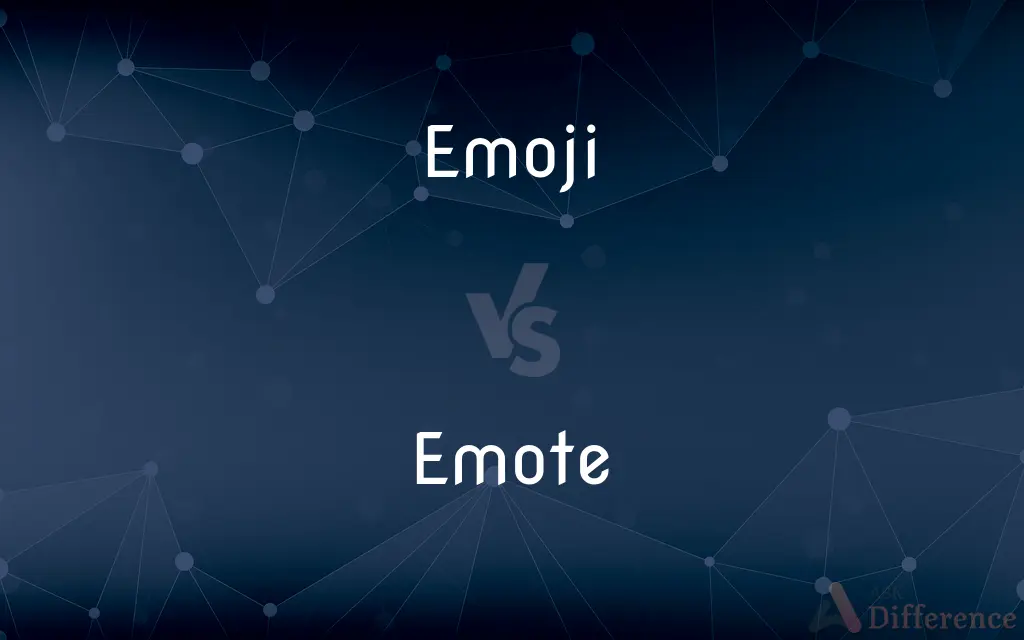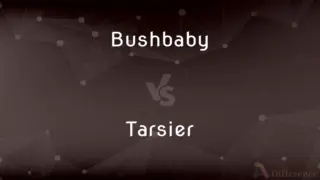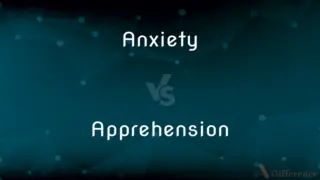Emoji vs. Emote — What's the Difference?
By Urooj Arif & Maham Liaqat — Updated on April 2, 2024
Emoji are pictorial symbols used in digital communication to express emotions, whereas emotes are text-based expressions that convey feelings or actions.

Difference Between Emoji and Emote
Table of Contents
ADVERTISEMENT
Key Differences
Emoji are small digital icons or images used across various platforms to express emotions, activities, or concepts in a compact, visual form. Originating in Japan, these symbols have become a universal language in digital communication, offering a wide range of expressions from simple smiley faces to complex symbols representing objects, weather conditions, and more. On the other hand, emotes are textual expressions that mimic facial expressions or convey actions, often used in online communications to add tone or emotion to messages. They are typically created from standard keyboard characters and might include representations of facial expressions (like ":)" for a smile) or abbreviations (like "LOL" for "laugh out loud").
The usage of emoji is facilitated by standardized sets available on most digital platforms, including smartphones, social media sites, and messaging applications. This standardization ensures that an emoji sent from one device is recognizable on another, albeit with slight variations in design across different platforms. Emotes, however, rely on the creativity and shared understanding of users, allowing for a wide range of personalized expressions. The lack of standardization in emotes means their interpretation can vary widely between different communities or cultural groups.
Emoji offer a visual and often colorful way to enhance digital communication, making messages more expressive and sometimes even replacing text altogether. Their popularity has led to the creation of thousands of emoji, each with specific meanings, approved and standardized by the Unicode Consortium. Emotes, while less visually complex, provide a flexible and quick way to convey emotions or actions using simple keystrokes, offering a form of expression that predates emoji and remains widely used in various online communities.
The choice between emoji and emotes often depends on the platform and the level of expressiveness desired. Emoji are universally recognized and can convey a broad range of emotions and concepts with a single character. Emotes, on the other hand, can offer a more nuanced or personalized expression, albeit with the limitation of being understood within a specific community or context.
Despite their differences, both emoji and emotes serve the fundamental purpose of enriching digital communication by providing a means to express emotions and nuances that might be lost in text alone. Whether through the vivid imagery of emoji or the imaginative simplicity of emotes, users can add depth and clarity to their messages, bridging the gap between written language and face-to-face interaction.
ADVERTISEMENT
Comparison Chart
Form
Pictorial symbols
Text-based expressions
Usage
Universal digital communication
Online communication, often in gaming or chat rooms
Standardization
Standardized by the Unicode Consortium
No standardization, varies by community
Expression
Broad range of emotions and concepts
Conveys emotions or actions using keyboard characters
Platform
Widely available across digital platforms
Used on specific platforms, dependent on shared understanding
Compare with Definitions
Emoji
Standardized and universally recognizable.
The smiley face emoji is recognized globally.
Emote
Lacks standardization, leading to creative variations.
New emotes emerge as users invent unique combinations.
Emoji
Offers a wide range of expressions.
From animals to weather conditions, emoji cover a vast array of themes.
Emote
Text-based expressions mimicking facial expressions or actions.
She typed :) to show her happiness in the chat.
Emoji
Digital icons representing emotions, concepts, or activities.
She sent a heart emoji to show her love.
Emote
Created from standard keyboard characters.
The emote XD represents laughter.
Emoji
Used to add visual expression to messages.
He used a series of emoji to tell the story.
Emote
Offers personalized expressions within communities.
Gamers often use specific emotes to communicate during gameplay.
Emoji
Can replace or accompany text.
A thumbs-up emoji can express agreement without words.
Emote
Predates emoji and remains widely used online.
Emotes like LOL have been used in digital communication for decades.
Emoji
Emoji or Emojis ( i-MOH-jee; from Japanese 絵文字 [emodʑi] lit. 'picture character'; plural emoji or emojis) are pictograms, logograms, ideograms and smileys used in electronic messages and web pages. The emoji's primary function is to fill in emotional cues otherwise missing from typed conversation.
Emote
An emote is an entry in a text-based chat client that indicates an action taking place. Unlike emoticons, they are not text art, and instead describe the action using words or images (similar to emoji).
Emoji
A small digital image or icon used to express an idea or emotion
Emoji liven up your text messages with tiny smiley faces
Emote
To express emotion, especially in an excessive or theatrical manner
"The more she emotes, the less he listens" (Maggie Scarf).
Emoji
A standardized ideogrammatic icon, as of a face or a heart, used especially in electronic messages or on webpages.
Emote
(transitive)
Emoji
Such icons considered collectively.
Emote
To display or express (emotions, mental states, etc.) openly, particularly while acting, and especially in an excessive manner.
Emoji
A digital graphic icon with a unique code point used to represent a concept, object, person, animal or place, originally used in Japanese text messaging but since adopted internationally in other contexts such as social media. Or, by extension, any non-standard emoji-like image inserted inline in text, i.e. an image emoticon.
Emote
To deliver (a speech), say (lines of a play, words), etc., in a dramatic or emotional manner, especially if overly so.
Emote
(intransitive)
Emote
To display (excessive) emotion, especially while acting.
Emote
To express a virtual action, presented to other users as a graphic or reported speech, rather than sending a straightforward message.
Emote
A virtual action expressed to other users as a graphic or reported speech rather than a straightforward message.
Emote
Give expression or emotion to, in a stage or movie role
Common Curiosities
Can emoji and emotes convey the same emotions?
Yes, both can express a wide range of emotions, though in different forms.
Why are emoji standardized?
Standardization ensures that emoji can be recognized and used universally across different platforms.
Can emotes be customized?
Yes, emotes allow for creative variations and personalization.
Do all digital platforms support emoji?
Most modern digital platforms support emoji, though their appearance can vary.
Are emoji replacing emotes in digital communication?
While emoji are widely used, emotes continue to be popular for their simplicity and flexibility.
How do emoji enhance digital communication?
Emoji add visual interest and clarity, conveying emotions and concepts that text alone might not fully express.
Can the meaning of an emote vary between communities?
Yes, the interpretation of emotes can differ widely depending on the community or cultural context.
How do users learn the meanings of emotes?
Through shared community use and sometimes through explicit explanations within the community.
Who decides on new emoji?
The Unicode Consortium approves and standardizes new emoji.
Are there any platforms where emotes are more popular than emoji?
In some online communities and gaming platforms, emotes are more commonly used for their specific cultural significance.
What is the primary difference between emoji and emote?
Emoji are pictorial symbols, while emotes are text-based expressions.
Do emoji and emotes serve the same purpose?
Both aim to enrich digital communication by adding emotional depth and nuance.
Why might someone choose to use an emote over an emoji?
For simplicity, personal preference, or because the emote offers a more precise expression in a given context.
Can the use of emoji and emotes lead to misunderstandings?
Yes, especially if the sender and receiver have different interpretations of the symbols or text.
How has the use of emoji and emotes evolved over time?
Their usage has expanded as digital communication has grown, adapting to new platforms and user needs.
Share Your Discovery

Previous Comparison
Bushbaby vs. Tarsier
Next Comparison
Anxiety vs. ApprehensionAuthor Spotlight
Written by
Urooj ArifUrooj is a skilled content writer at Ask Difference, known for her exceptional ability to simplify complex topics into engaging and informative content. With a passion for research and a flair for clear, concise writing, she consistently delivers articles that resonate with our diverse audience.
Co-written by
Maham Liaqat













































